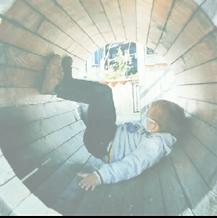ABOUT THE PORTFOLIO
Cities are designed for people and shaped by people. With community as a central element of the design approach, the selected projects demonstrate the possibilities of community-based planning, design, and conservation and showcase urban design as a solution to urban problems.
The portfolio is a combination of academic, work, and social advocacy projects. The projects explore urban solutions from different perspectives, from conceptual design to actual practices. The portfolio also shows how local government, developers, and the community should work together to achieve economic and social sustainability.
PROGRAMS USED
Adobe Creative Suite (Illustrator, Photoshop, InDesign)
ArcGIS (Pro, Online, StoryMaps, Experience Builder)
SketchUp
Microsoft Excel (Data Modeling) AutoCAD Rhino
WHOM DO WE PLAN FOR?
PROJECT: PICO RIVERA SPORTS & ENTERTAINMENT DISTRICT
WHAT IS THE LANGUAGE
PROJECT: LA CHINATOWN BROADWAY PLACEKEEPING PROJECT
HOW TO WORK TOGETHER
PROJECT: ELYRIA CANYON PARK COMMUNITY CO-DESIGN PROJECT
WHAT IS THE PERSONALITY
PROJECT: THE EDGY QUARTER IN LA LITTLE TOKYO
HOW TO MAKE IT HAPPEN
PROJECT 1: YUZI PARK (GUILIN, CHINA)
PROJECT 2: CULTURAL GOLDEN TRIANGLE DISTRICT (BEIJING, CHINA)
WHOM DO WE PLAN FOR?
PROJECT: PICO RIVERA SPORTS & ENTERTAINMENT DISTRICT, LOS ANGELES
Each urban project changes the social fabric and economic dynamics of the existing community. Understanding the expectations and concerns of community members from the past, present, and future is essentially important to managing the changes of the community.
ABOUT THE PROJECT:
Impacted by flooding issues, the City of Pico Rivera has to relocate the historic Sports Arena and a new Sports and Entertainment District is planned at an existing industrial center which will completely repurpose the area. The main challenge is to get the support of industrial players and build a new community.
The project delivers a collaborative planning proposal that intends to smoothly transition the current economy, revive the community memories, and connect Pico Rivera to a broader community.
THE KEY PRINCIPLES ARE:
• Adopt a locally sensitive plan
• Encourage collaboration with multiple stakeholders
PROJECT TYPE: School Capstone Individual Project - 2024
(Client: City of Pico Rivera)
WHO IS THE
GOAL 1: Amplify the cultural impact of Pico Rivera Sports Arena and build a regional cultural and entertainment hub through unique cultural expression.
1.REGIONAL

Data Source: U.S. Census Data 2022
2.PICO RIVERA
WHAT DO HISTORIC PHOTOS TELL US ABOUT PICO RIVERA’S CULTURE?
Data Source: 453 historic photos that the community posted on Facebook
GOAL 2: Strengthen community identity and diversify public life through community-led programming.
GOAL 3: Transition industrial businesses to creativity-driven economy with collaborative planning and locally sensitive phasing plan.
COMMUNITY?
3. PROJECT SITE

COLLABORATIVE PLANNING
Phase I Phase II
Phase III
Pico Rivera lovers
Pico Rivera community
Public education: “how much do you know about flooding”
Survey: Love Notes to Pico Rivera!
Visioning: “How do you want to use the space?”
Industrial players
Scope
Strategy
Roof-sharing Program

Parking Lots Activation Program

Programming: Bimonthly event calendar
Mixed-use Industrial Incubation Program




GROUND-TO-ROOF INTERVENTION


SPACE ACTIVATION





ROOF-TO-GROUND DEVELOPMENT



THE CALL OF RIPPLES
• Cultural identity: the urban design concept is a combination of the cultural symbols like Mariachi plaza and Pico Rivera Memorial Sports Arena, and ripples of river which Pico Rivera has a unique bond with.
• Economic sustainability: the project will keep 65% of the job on site and ensure smooth economic transition by adapting current businesses

LEGEND Green Space
Key Project Recreational Space
Potential Partners

WHAT IS THE LANGUAGE
PROJECT: LA CHINATOWN BROADWAY PLACEKEEPING PROJECT, LOS ANGELES
Every place has its community, and every community has their language. While planning policies define the norms of urban design, communities have different definitions of “clean” and “chaotic”, “safe” and “dangerous”, “historic” and “modern”. Every project requires a unique design dictionary.
PROJECT PROFILE:
Los Angeles’s Chinatown is a home for various ethnic communities, many of whom face the challenges of economic downturn and gentrification. The fragmentation of the communities make collective efforts harder.
With a year-long engagement with the community, the project delivered a design advocacy proposal aimed to advocate a culturally sensitive development of the historic commercial corridor to augment the character of LA Chinatown, encourage community interaction, and enhance the economic and social sustainability.
THE KEY PRINCIPLES ARE:
• Celebrate the shared culture and build solidarity
• Alleviate the tension between preservation and development
PROJECT TYPE: Design Advocacy Project - 2023
(Partner: Chinatown Community for Equitable Development )
NOT JUST CHINESE1

NOT JUST STOREFRONTS2
SETTLE DOWN HERE... AT BROADWAY
Mai Tu is a 34-year-long local jeweler in Chinatown.

In 1960s, Mai and her family escape from China to Vietnam
In 1978, Mai and her family got on a refuge boat to escape the political persecution.
AND BROADWAY
HOW DOES THE COMMUNITY PERCEIVE THE SPACE?3

The boat capsized but Mai got rescued and shipped to Norway and her parents to Malaysia.
“I like them. I usually go there for...”
HOW ACTIVE ARE THESE SPACES OVER A DAY?4
In 1983, they reunioned in LA Chinatown and Mai started her own jewelry business in 1990

In 2020, Mai got evicted to Dynasty Center. Since then Mai becomes an community activist and contually fights against gentrification in Chinatown
GO “STREET-STROLLING”
ALLEY MAKING DEVELOPMENT
Alley is an important part of Asian culture. Traditionally, shopping in Asia always happens on streets and alleys. Even to today, Chinese people still call shopping as “street-strolling”
Preserving and creating more alleys is the key to an experience-based development that offers a unique and authentic Chinatown vibe. There are a lot of potential alleys along Broadway.
Therefore, the plan focuses on the “street-strolling” experience and suggests connecting the main street and cross streets with indoor and outdoor alleys. Preservation and new development should be based on the street and alley net work to support a well-connected street life.
ALLEY MAKING STRATEGY





 MAIN STREET
CROSS STREETS
MAIN STREET
CROSS STREETS
STREETS



MAIN STREET

CROSS STREETS

ALLEYS

PLANNING TOOL: CULTURAL DISTRICT
BEFORE AFTER

FROM DAILY TO CEREMONIAL



ALLEY-MAKING DEVELOPMENT-MEDIUM
SOCIAL TOOL: BUSINESS COOPERATIVE
BEFORE AFTER


ALLEY-MAKING DEVELOPMENT-LARGE

SOCIAL TOOL: COMMUNITY LAND TRUST
BEFORE AFTER

HOW TO WORK TOGETHER
PROJECT: ELYRIA CANYON PARK COMMUNITY CO-DESIGN PROJECT, LOS ANGELES
The community always has the most knowledge of the site and often time knows the best what is needed in a project. Therefore, the best way of design is working with the experts.
PROJECT PROFILE:
Elyria Canyon is a hidden park surrounded by neighborhoods of various income levels and ethnic backgrounds. Community Nature Connection (CNC), a local organization operates the park and strives to increase public access to the park by working with the underserved communities.
In the project, the design team worked with the community to identify the main focus of the operation of the park, design the park, and develop CNC volunteers’ capacity of collaborative design and community engagement. A final design manual was delivered to CNC for fundraising and implementation.
THE KEY PRINCIPLES ARE:
• Mutual learning between project team and the community
• Creative engagement and collaborative design methods
PROJECT TYPE: School Project for Community-based Planning, Design, and Conservation-2023 (Partner: Community Nature Connection)







WHAT DO YOU WANT FOR THE SITE?
WOOD AMPHITHEATER

STONE AMPHITHEATER


SEMI-ENCLOSED GARDEN NATURAL GARDEN







SITE DESIGN
PARK DESIGN

THE RED BARN
LEGEND DESIGN LIBRARY
Main
Minor
Parking
Low-difficulty trail
Medium-difficulty trail
High-difficulty trail








PLANTING LIST
WHAT IS THE PERSONALITY
PROJECT: THE EDGY QUARTER IN LITTLE TOKYO, LOS ANGELES
Places have their own personalities and attract their own audience. Sometimes the best way to revitalize a place is to discover and augment its character. Even features commonly assumed undesirable have their value, attractiveness, and power.
PROJECT PROFILE:
The project is located at the edge of the historic Little Tokyo, neighboring Old Chinatown, Art District, and Boyle Heights. While the site has long born a negative tag of darkness, it has also offered a shelter for people who dance in the dark.
Darkness and light, they always coexist. The project is intended to create a secret celebration venue for people who see the shadow in the light and who chase light in the darkness.
THE KEY PRINCIPLES ARE:
• Maintain the duality of day and night, “good” and “evil”
• Encourage the fusion of immigration roots and progressive culture
PROJECT TYPE: School Project for Design Skills for Urban Planning - 2024

THE EDGY QUARTER FOR THE NIGHT-BLOOMING FLOWERS

HOW TO MAKE IT HAPPEN
PROJECT 1: YUZI PARK, GUILIN, CHINA
PROJECT 2: CULTURAL GOLDEN TRIANGLE DISTRICT, BEIJING, CHINA
How can the project contribute to employment? How profitable the project is? How can the project be implemented and operated in the long run? Ultimately, we need to think about it practically.
PROJECT 1 PROFILE:
Yuzi Park is an undeveloped natural resort. After years’ of investment into local art with little return, the client needed to capitalize the natural and art resources and resume the tourism of Guilin city.
The project aims to propose a plan that makes the site marketable and a new cultural landmark of Guilin. The final report was approved by the City.
PROJECT TYPE: Work Project - 2022 (Client: Yuzi Park, Guilin City)
PROJECT 2 PROFILE:
Golden Triangle District is the cultural center of Beijing. The substantially high density of historic resources and outdated amenities make the area lag behind in economic vibrancy. The project aims to transform the cultural advantage of the area into economic value. The strategy is to deeply work with multiple stakeholders and create economic opportunities by innovating planning tools and operation models while maintaining the historic essence. The final report was approved by the client and several proposed projects were implemented.
PROJECT TYPE: Work Project - 2018 (Client: Beijing City)
YUZI PARK
Guilin
Liuzhou
Nanning
Foshan
Dongguan
Changsha
Chengdu
Guangzhou Shenzhen
Zhongshan Beijing Shanghai
Tianjin
Chongqing
Wuhan
Nanjing
Suzhou
Hangzhou Ningbo








The Land-Campsite
The Forest-Treehouse
The Starry Night-Theater
The Universe-VR Art Show














GOLDEN TRIANGLE DISTRICT
FOUR INITIATIVES
Memory Museum
Collect historic stories and community memories of the area, create public art and community exhibitions, and post stories online.
Economic Revitalization
Develop theater, art trade, and publishing industries. Support the commercialization of art and complete the ecosystem.
Historic Community
Activate community life and enhance “Hutong” experience by creating unique cultural space and supporting traditional artists.
Cultural Consumption
Promote cultural consumption through infusing cultural scenes, co-branding with historic landmarks, and membership program.
Cultural innovation center
Central Axis of Beijing
Cultural Core

EXEMPLARY PROJECTS
Working with the city, the project designed several public-private collaboration model, selected suitable partners, and pushed forward the implementation of several exemplary projects.
Concerts in Historic Buildings - “The Echo of History”
Zhizhu Temple is selected as the site for concerts of traditional and fusion music. The concert has now become a iconic cultural experience in Beijing and is held regularly.

Theater Incubation Center- “The Theater Factory”
Nanyang-Gongxiangji is a mixed-use theater incubation center that include a historic theater, studio space, hotel and cultural retails. Renovated and managed by a progressive developer, the project is a now an incubator for innovative plays that inherit and expand the traditional genre.

Community Cultural Center- “The Flow of Hutong Life”
Mei Hou Si Shi is a community center owned by the city and managed by a culture operator. The project innovated a public-private partnership in public space management. The center connects traditional artists and the community and has developed many self-organized art clubs.

• EAST LA FOOD GUIDE: https://experience.arcgis.com/experience/41efc5670275478db121f0948bee57cf/
• NEW CHINATOWN = NO CHINATOWN? : https://storymaps.arcgis.com/stories/2e21a5eb76ec4ccd84992e039af748d5
COMMUNITY ENGAGEMENT HIGHLIGHTS:
• Safer Streets in Our Community (East LA)




• Why We Stay, Why We Fight (City Terrace)

• Listen to The People (LA Chinatown)





• The Future of Small Business (LA Chinatown)





